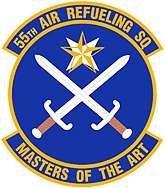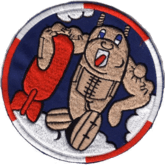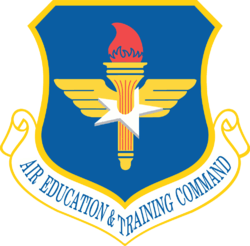55th Air Refueling Squadron
| 55th Air Refueling Squadron | |
|---|---|
_(15566186388).jpg) | |
| Active | 1943–1945; 1950–1954; 1955–1963; 1994–2009 |
| Country |
|
| Branch |
|
| Role | Air refueling |
| Part of | Air Education and Training Command |
| Nickname(s) | Monkeys |
| Motto(s) | Masters of the Art[1] |
| Engagements | European Theater of Operations[1] |
| Decorations | Air Force Outstanding Unit Award[1] |
| Insignia | |
| 55th Air Refueling Squadron emblem (approved 13 April 1995)[1] |
 |
| Patch with 755th Bombardment Squadron emblem (approved 20 March 1945)[2] |
 |
The 55th Air Refueling Squadron was a part of the 97th Air Mobility Wing at Altus Air Force Base, Oklahoma. It formerly operated both the Combat Crew Training School and Central Flight Instructor Course for Boeing KC-135 Stratotanker aircrew qualification training.
Mission
The squadron's mission is training of active duty, guard, reserve, and international KC-135 crew members.[3]
History
World War II

The first predecessor of the unit, the 755th Bombardment Squadron was activated on 1 July 1943, at Wendover Field, Utah. Beginning in 1944, the 755th was stationed at RAF Horsham St Faith, Norfolk, England. During 1944 and 1945, the 755th flew Consolidated B-24 Liberator combat missions in the European Theater of Operations earning seven campaign streamers and the distinction of being the test squadron for the Army Air Forces' first guided bomb project.[3]
Air refueling operations
The squadron's second predecessor, the 55th Air Refuyeling Squadron was activated on 1 November 1950. It was originally equipped with Boeing KB-29 tankers and was assigned to the 55th Strategic Reconnaissance Group at Ramey Air Force Base, Puerto Rico. On 10 October 1952, the squadron moved to Forbes Air Force Base, Kansas, as part of the 55th Strategic Reconnaissance Wing. Two years later, on 16 February 1954, the squadron moved to Lincoln Air Force Base, Nebraska, where it was inactivated two days later.[3]
The 55th Air Refueling Squadron was again reactivated on 1 October 1955, and assigned to the 55th Strategic Reconnaissance Wing at Forbes Air Force Base, Kansas, and was equipped with Boeing KC-97 Stratotanker aircraft. First introduced into the Air Force inventory in 1951, the tanker could fly fast enough to refuel the Boeing B-47 Stratojet bomber, thus providing the Air Force with an intercontinental strike capability.[3]
The squadron deployed to Ernest Harmon Air Force Base, Newfoundland, from 31 October through 27 December 1956 in response to the Suez Crisis. During this period, the squadron participated in giant simulated combat missions involving 1,000 B-47s and KC-97s, demonstrating the United States' resolve and intercontinental war fighting capability. The deployment was instrumental in the squadron winning an Air Force Outstanding Unit Award for the period July 1956 to November 1957. During the 1959 Strategic Air Command bombing competition, the largest held to date, the 55th again demonstrated its combat readiness by winning the Saunders Trophy as the best air refueling unit in Strategic Air Command. The squadron was inactivated again in 1963.[3]
On 28 October 1994, the 55th Air Refueling Squadron was activated as part of the 97th Air Mobility Wing at Altus Air Force Base, Oklahoma. The 55th Air Refueling Squadron, along with the 54th Air Refueling Squadron, were once the only two Air Education and Training Command Boeing KC-135R Stratotanker flying training squadrons. Both squadrons provided KC-135R initial and advanced flight qualification. On 31 March 2009, the 55th Air Refueling Squadron was inactivated,[3] leaving the 54 ARS as the lone remaining AETC KC-135 unit.
Lineage
- 755th Bombardment Squadron
- Constituted as the 755th Bombardment Squadron (Heavy) on 19 May 1943
- Activated on 1 July 1943.
- Redesignated 755th Bombardment Squadron, Heavy on 20 August 1943
- Redesignated 755th Bombardment Squadron, Very Heavy on 5 August 1945
- Inactivated on 17 Oct 1945
- Consolidated with the 55th Air Refueling Squadron on 19 September 1985[1]
- 55th Air Refueling Squadron
- Constituted as the 55th Air Refueling Squadron, Medium on 22 November 1950
- Activated on 1 November 1950
- Inactivated on 18 February 1954
- Activated on 1 October 1955
- Discontinued and inactivated on 15 March 1963
- Consolidated with the 55th Air Refueling Squadron and redesignated 55th Air Refueling Squadron, Heavy on 19 September 1985
- Redesignated 55th Air Refueling Squadron on 31 May 1994
- Activated on 28 October 1994[1]
Assignments
- 458th Bombardment Group, 1 July 1943 – 17 October 1945
- 55th Strategic Reconnaissance Group, 1 November 1950 (attached to 55th Strategic Reconnaissance Wing after 8 Jan 1951)
- 55th Strategic Reconnaissance Wing, 16 June 1952 – 18 February 1954
- 55th Strategic Reconnaissance Wing, 1 October 1955 – 15 March 1963 (attached to Eighth Air Force, 31 October–27 December 1956)
- 97th Operations Group, 28 Oct 1994 – [1]
Stations
|
|
Aircraft
- Consolidated B-24 Liberator (1943–1945)
- Boeing B-29 Superfortress (1945)
- Boeing KB-29 Superfortress (1950–1954)
- Boeing KC-97 Stratotanker (1955–1963)
- Boeing KC-135 Stratotanker (1994–2009)[1]
References
Notes
- Explanatory notes
- ↑ Aircraft is Consolidated B-24H-10-DT Liberator serial 41-28678. This aircraft was lost due to mechanical failure on 22 March 1944 mission to bomb the BMW engine factory at Basdorf outside Berlin, Germany. Eight of the crew became POWs and one was killed because he did not have the right type of harness for his parachute and went down with the plane.
- Citsations
- 1 2 3 4 5 6 7 8 9 Robertson, Patsy (24 September 2008). "Factsheet 31 Fighter Wing (USAFE)". Air Force Historical Research Agency. Archived from the original on 28 September 2015. Retrieved 22 December 2017.
- ↑ Maurer, Combat Squadrons, pp. 737-738
- 1 2 3 4 5 6 "Library: Fact Sheet 55th Air Refueling Squadron". 97th Air Mobility Wing Public Affairs. 29 July 2008. Archived from the original on 29 October 2013. Retrieved 22 December 2017.
Bibliography
![]()
- Maurer, Maurer, ed. (1983) [1961]. Air Force Combat Units of World War II (PDF) (reprint ed.). Washington, DC: Office of Air Force History. ISBN 0-912799-02-1. LCCN 61060979. Retrieved 17 December 2016.
- Maurer, Maurer, ed. (1982) [1969]. Combat Squadrons of the Air Force, World War II (PDF) (reprint ed.). Washington, DC: Office of Air Force History. ISBN 0-405-12194-6. LCCN 70605402. OCLC 72556. Retrieved 17 December 2016.
- Ravenstein, Charles A. (1984). Air Force Combat Wings, Lineage & Honors Histories 1947-1977 (PDF). Washington, DC: Office of Air Force History. ISBN 0-912799-12-9. Retrieved 17 December 2016.


